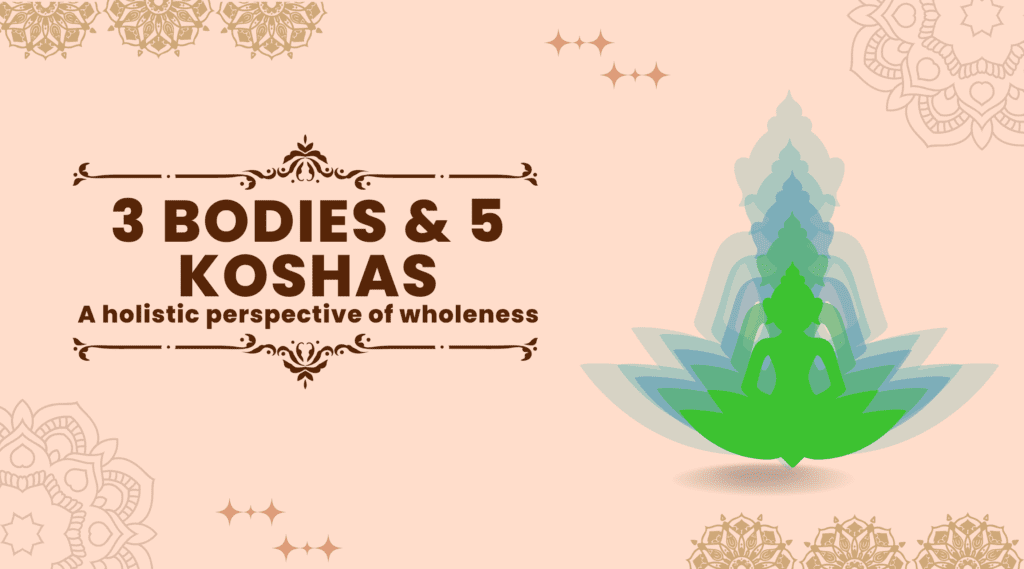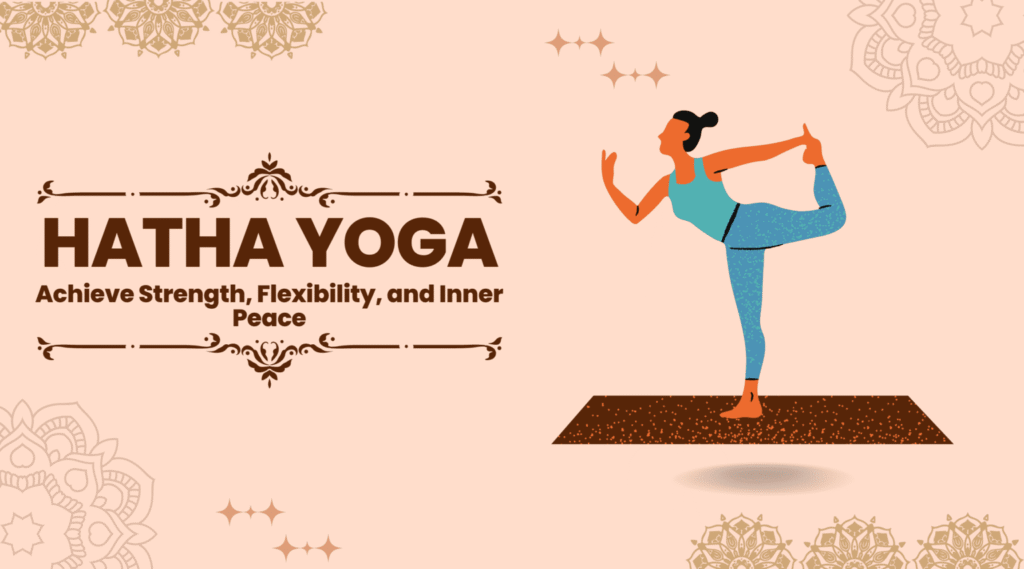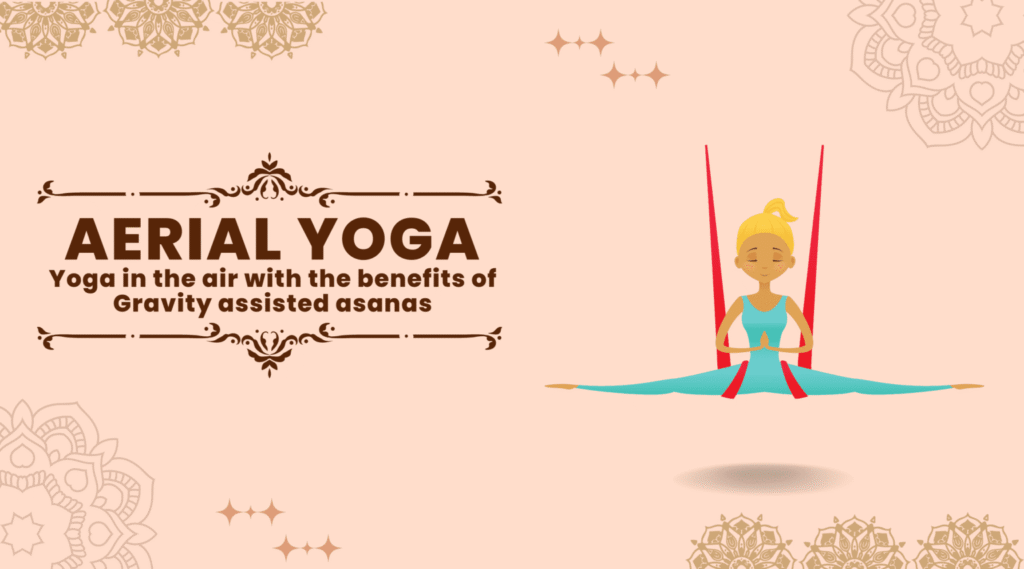
Introduction
Have you ever thought about the true nature of us human beings? Such as who we are beyond our name and physical appearance. As per Yoga philosophy we human beings are not just a physical body of bones, muscles and blood but three bodies with different layers that are essential for our existence. These layers are known as five koshas. They are the key for unlocking the knowledge of oneself.
In this blog, we will discuss the 3 bodies and 5 koshas, have a deep dive into the layers of our being, and discover who we really are.
According to the philosophy of Yoga, a human being has three bodies and five koshas.
The three bodies also known as the tripartite model of human existence are: Physical body (Sthula sharira), Astral/Subtle body (Sukshma sharira), and the Spiritual/Casual body (Karana sharira also called the soul). They are connected to one another by an energy called “Prana”.
And the five koshas are: Annamaya kosha, Manomaya kosha, Pranamaya kosha, Vijnanamaya kosha and Anandamaya kosha. Now let’s explore the concept of the three bodies and five koshas in more detail.
Suggested: Best Yoga Retreats And Yoga Teacher Training In Rishikesh
1. The Physical Body (Sthula Sharira)
The physical body is the tangible, visible aspect of the human being. The physical body has bones, muscles, organs as well as all the other parts that make up your physical form. It is made up of the five elements: earth, water, fire, air, and ether.
This is why we need to consume these five elements daily to maintain our physical body. It is the vehicle through which we interact with the world and experience sensations, emotions, and thoughts.The science of Ayurveda also follows the principle that these five elements must be refreshed regularly in order to keep the body healthy.
In yoga, we practise asanas (yoga postures) as well as meditation to balance these elements for improving and maintaining the health & vitality of our physical bodies.
2. The Astral/Subtle Body (Sukshma Sharira)
The Astral or subtle body is the non-physical aspect of the human form and underlies the physical body. It is not visible to human eyes. Astral body creates a connection between the physical body and spiritual body. It consists of the mind (manas), intellect (buddhi), ego (ahankara), and the senses (Indriyas).
The Astral/subtle body is responsible for our thoughts, emotions, perceptions and actions. It is also the vehicle through which we connect with the spiritual realm. Chakras and Nadis also lie in this body. This body consists of nineteen elements:
5 Senses of Knowledge (Gyan Indriyas):
- Jihva (Tongue): The sense organ of taste, which allows individuals to perceive different flavours and tastes in the environment.
- Shrotra (Ears): The sense organ of hearing, that allows individuals to perceive sounds and vibrations in the environment.
- Chakshu (Eyes): The sense organ of sight, that allows individuals to perceive colours, shapes, and forms in the environment.
- Ghrana (Nose): The sense organ of smell, which allows individuals to perceive different scents and odours in the environment.
- Tvak (Skin): Is the sense organ of touch. This allows individuals to perceive different textures, temperatures, and sensations in the environment.
5 Organs of Action (Karma Indriyas):
- Pani (Hands): This includes the organs responsible for handling and manipulating objects, such as the hands, fingers, and arms.
- Upastha (Reproductive organs): This includes the organs responsible for procreation and sexual activity, such as the genitals.
- Pada (Feet): This includes the organs responsible for movement and locomotion, such as the feet, legs, and hips.
- Vak (Speech): This includes the organs responsible for speaking and communication, such as the tongue, lips, and vocal cords.
- Payu (Excretion): This includes the organs responsible for eliminating waste from the body, such as the rectum and anus.
4 Elements of Antahkarana
1. Manas (Mind): This is the aspect of the Antahkarana that is responsible for receiving and processing sensory information. It is the aspect of the mind that generates thoughts and impressions based on the information received from the senses.
2. Buddhi (Intellect): This is the aspect of the Antahkarana that is responsible for discrimination, judgement, and decision-making. It is the aspect of the mind that allows individuals to analyse and evaluate information and make informed choices.
3. Chitta (Memory): This is the aspect of the Antahkarana that is responsible for storing and retrieving information. It is the aspect of the mind that allows individuals to recall past experiences and knowledge.
4. Ahamkara (Ego): This is the aspect of the Antahkarana that is responsible for a sense of individuality and self-awareness. It is the aspect of the mind that creates a sense of identity and personal agency.
5 Pranas (Pancha vayu):
The Astral body requires prana for its functioning. Prana is the subtle energy that we need to do different activities such as speaking, thinking, walking etc. Yoga, Pranayama and meditation are the practices that balance our subtle bodies.
There are five pranas:
1. Udana: The energy or vital force located above the heart. Udana controls body functions in this region such as the brain, hands, nose and eyes. We get Udan Prana from the element of space. The space element is located above the air in the atmosphere. This is the reason why we absorb more of the space element when the sky is clear.
2. Prana: Prana clearly acts in the region of the heart and is responsible for controlling the heartbeat. So, we should thank Prana for a healthy heart. We receive prana from the air element. By practising pranayama, you can control your breath and improve the flow of prana towards the heart. It may promote heart health as well as emotional well-being.
3. Samana: Is the energy responsible for both metabolism and digestion in the human body. It is located four fingers above the navel in the solar plexus, just below the rib cage.We gain this energy from the sun as well as physical exercise.
4. Apana: Apana is the power of excretion. This prana draws out the waste and toxins from the body. We can obtain Apana by eating foods made from the soil, such as root vegetables, grains and legumes. Apana is situated in the pelvic region, which houses the lower abdomen, hips, and reproductive organs.
5. Vyana: Is an essential energy of movement and circulation.Vyana circulates the blood as well as other bodily fluids across the body. We get Vyana from water, which is important for maintaining fluid balance in the body. Vyana is situated 3-4 fingers below the navel/belly button, but the Ayurveda considers its primary location in the heart.
3. The Causal Body (Karana Sharira)
The causal body is the deepest, most subtle aspect of the human form. It is also called the seed body. This body is the source of all existence and the seed of individual consciousness. It is the storehouse of all our past experiences, impressions and desires. This body does not change and continues through all your lives present and past.
It stores subtle impressions of everything that has happened to you in this life and past lives, in the form of karma. Hence, the causal body ensures the development of the physical and subtle bodies in the next birth. When we die the spiritual body takes on a new physical and subtle body. This is the process of reincarnation.
Apart from that spiritual body is the body that connects us to the divine. As a result, we can use it as a vehicle to achieve the ultimate goal of our practice: enlightenment and self-realisation. The spiritual body has its elements as under:
- Free will
- Samskara
- Karma
- Soul
The Five Koshas
The five koshas, also known as the five sheaths or layers, are the means through which the three bodies interact with each other and with the world. Each kosha represents a different aspect of the human experience and is interconnected with the others. The five Koshas are:
1. Annamaya Kosha (Physical Sheath)
The annamaya kosha is the physical sheath, which corresponds to the physical body. It is the first and outermost layer of the human form and is made up of the five elements. The annamaya kosha is responsible for our physical sensations and experiences.
2. Pranamaya Kosha (Vital Sheath)
The pranamaya kosha is the vital sheath, which corresponds to the subtle body. It is the layer of the human form that is responsible for our life force or prana. The pranamaya kosha is responsible for our breath, energy, and vitality.
3. Manomaya Kosha (Mental Sheath)
The manomaya kosha is the mental sheath, which corresponds to the mind. It is the layer of the human form that is responsible for our thoughts, emotions, and perceptions. The manomaya kosha is responsible for our mental experiences.
4. Vijnanamaya Kosha (Intellectual Sheath)
The vijnanamaya kosha is the intellectual sheath, which corresponds to the intellect. Our wisdom, intellect and intuition lie in Vijnanamaya KoshaIt. It is the layer of the human form that is responsible for our discernment, reasoning, and judgement. The vijnanamaya kosha is responsible for our intellectual experiences. Hence it is very important for our spiritual growth.
5. Anandamaya Kosha (Blissful Sheath)
The anandamaya kosha is also called the blissful sheath, which corresponds to the causal body. Anandamaya Kosha is considered the innermost layer, encompassing the other four koshas.This Kosha enables us to feel joy, love & affection, and happiness. It is the layer of the human form that is responsible for our spiritual experiences.
This kosha is associated with the spiritual aspect of our existence and is accessed through practices such as deep meditation, self-inquiry, and spiritual awakening. By transcending the limitations of the other koshas, individuals can connect with their Anandamaya Kosha and experience a deep sense of inner joy, peace, and fulfilment.
Exploring and nurturing the Anandamaya Kosha is a journey of self-discovery as well as spiritual growth,
Conclusion
Understanding the concept of the three bodies and five koshas provides us with a profound framework for exploring our holistic nature while realising our true potential. The physical, energetic, mental, intellectual and blissful sheaths together form a multi-dimensional map of our being. This map offers insights into different aspects of our existence.
By recognizing and working with these layers, we can embark on a transformative journey of self-discovery as well as self-realisation. Through practices such as yoga, meditation, breathwork, and self-reflection, we can harmonise and balance these koshas, fostering optimal well-being and personal growth.
You Can Also Read


